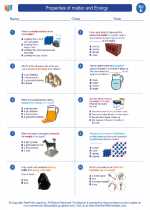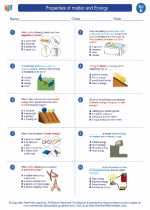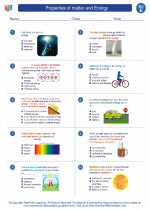Properties of matter and Energy -> photosynthesis
Photosynthesis
Photosynthesis is the process by which green plants, algae, and some bacteria convert light energy, carbon dioxide, and water into glucose and oxygen. This process is crucial for the survival of almost all life forms on Earth as it produces the oxygen we breathe and provides the basis for the food chain.
Key Concepts
- Chloroplasts: These are the specialized organelles in plant cells where photosynthesis takes place. They contain the pigment chlorophyll, which gives plants their green color.
- Light-Dependent Reactions: These reactions occur in the thylakoid membranes of the chloroplasts and require light energy to produce ATP and NADPH, which are used in the next stage of photosynthesis.
- Light-Independent Reactions (Calvin Cycle): These reactions occur in the stroma of the chloroplasts and use the ATP and NADPH produced in the light-dependent reactions to convert carbon dioxide into glucose.
- Factors Affecting Photosynthesis: Factors such as light intensity, carbon dioxide concentration, and temperature can affect the rate of photosynthesis.
Study Guide
Here are some key points to remember and study for the topic of photosynthesis:
- Understand the overall chemical equation for photosynthesis:
6CO2 + 6H2O + light energy → C6H12O6 + 6O2 - Be able to explain the role of chloroplasts, chlorophyll, and other pigments in capturing light energy.
- Describe the two stages of photosynthesis (light-dependent reactions and light-independent reactions) and their specific locations within the chloroplast.
- Understand the importance of ATP and NADPH in providing energy and reducing power for the synthesis of glucose.
- Be familiar with the factors that can limit the rate of photosynthesis and how they impact the process.
It's also helpful to review diagrams and animations of the photosynthesis process to better visualize how the light energy, carbon dioxide, and water are transformed into glucose and oxygen.
Remember, photosynthesis is a fundamental process in the natural world and plays a crucial role in the balance of oxygen and carbon dioxide in the atmosphere, as well as the production of food for living organisms.
.◂Science Worksheets and Study Guides Fifth Grade. Properties of matter and Energy

 Worksheet/Answer key
Worksheet/Answer key
 Worksheet/Answer key
Worksheet/Answer key
 Worksheet/Answer key
Worksheet/Answer key
 Vocabulary/Answer key
Vocabulary/Answer key
 Vocabulary/Answer key
Vocabulary/Answer key
